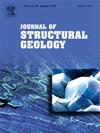Unsteady transpression: How progressive variations in kinematic vorticity influence finite strain in shear zone evolution
IF 2.9
2区 地球科学
Q2 GEOSCIENCES, MULTIDISCIPLINARY
引用次数: 0
Abstract
Natural shear zones usually follow unsteady deformation histories. Concerning transpression zones, it is expected that the vorticity of the flow will vary not only in space but also in time. This work presents a study of unsteady flows that considers two ideal extreme cases: one, here named Type i, in which the vorticity increases with time, from virtual pure to simple shearing (Wk = 0.01 to 0.999), and another, Type d, in which vorticity decreases with time, from virtual simple to pure shearing (Wk = 0.999 to 0.01). To tackle the issue of vorticity changes during progressive strain, we modeled the evolution of a vertical transpression zone with left lateral movement and vertical extrusion, considering four basic types of shear zone growth. The results show that, in many cases, the resulting fabrics are difficult to distinguish from those of a steady flow. There are situations, however, in which the pattern of foliations, the orientation of stretching lineations, or an abnormally high magnitude of local non-coaxiality may be criteria to identify the unsteady character of the flow. Under Type i flows, the spin undergone by the instantaneous stretching axes, antithetic to the rotation imposed by the vorticity vector, should have consequences in an exceptionally high non-coaxiality of the fabric, and can induce an antithetic rotation of the foliation. In some cases, the resulting foliation pattern can be sigmoidal, whose tips indicate the direction of relative displacement of the adjacent blocks. Other pieces of evidence detected in the fabric patterns that may indicate unsteadiness in the flow are: a) zones with low deformation intensity that nevertheless show lineations parallel to the extrusion direction; b) local zones of very high non-coaxiality (reflected in rock fabrics - high asymmetric porphyroclasts or CPOs), higher than that imposed by the total vorticity; and c) the coexistence of mutually orthogonal stretching lineations without evidence of steady deformation trajectories to justify it. Our model also suggests that, when temporal strain partitioning is identified in a shear zone, the main evidence of unsteadiness of the flow would be found in bands where the non-coaxial component is eventually concentrated. For the rest of the shear zone, the variations in strain trajectories are so small compared to those of steady flows that the assumption that the flow is steady may be considered valid. We have tested the model into two natural shear zones: one where vorticity increase has been already noticed (Balaram Shear Zone in the northwestern part of the Indian Peninsula) and another one where unsteady transpression is presented as a simpler explanation than the provided steady analytic models (a high strain zone in Cap de Creus, Eastern Pyrenean Axial Zone).
非定常压缩:运动涡度的渐进变化如何影响剪切区演化中的有限应变
自然剪切带通常遵循非稳态变形历史。在高压区,预计气流的涡度不仅在空间上变化,而且在时间上变化。本文研究了两种理想的极端情况:一种是涡量随时间增加,从虚纯剪切到单纯剪切(Wk = 0.01至0.999)的i型,另一种是涡量随时间减少,从虚简单剪切到纯剪切(Wk = 0.999至0.01)的d型。为了解决渐进式应变过程中涡度变化的问题,我们模拟了一个具有左移和垂直挤压的垂直变形带的演变,考虑了剪切带生长的四种基本类型。结果表明,在许多情况下,所得织物很难与稳定流动的织物区分开来。然而,在某些情况下,叶理的模式、拉伸线的方向或局部非同轴度的异常高的幅度可能是识别流动非定常特征的标准。在i型流动下,瞬时拉伸轴所经历的自旋与涡度矢量施加的旋转相反,应该会导致织物的异常高的非同轴性,并可能引起叶理的反向旋转。在某些情况下,产生的叶理模式可能是s形的,其尖端表明相邻块体的相对位移方向。在织物图案中检测到的其他可能表明流动不稳定的证据是:a)变形强度低的区域,但显示出与挤压方向平行的线条;b)非常高非同轴度的局部区域(反映在岩石组构-高不对称斑岩碎屑或cpo中),高于总涡度所施加的区域;c)相互正交的拉伸线共存,没有稳定变形轨迹的证据来证明这一点。我们的模型还表明,当在剪切区确定时间应变分配时,流动不稳定的主要证据将出现在非同轴分量最终集中的带中。对于剪切带的其余部分,应变轨迹的变化与稳定流动的变化相比是如此之小,以至于流动稳定的假设可能被认为是有效的。我们已经在两个自然切变带中测试了该模型:一个是已经注意到涡度增加的区域(印度半岛西北部的巴拉拉姆切变带),另一个是非稳定压缩的解释比提供的稳定分析模型更简单(位于东比利牛斯轴向带的Creus角的高应变区)。
本文章由计算机程序翻译,如有差异,请以英文原文为准。
求助全文
约1分钟内获得全文
求助全文
来源期刊

Journal of Structural Geology
地学-地球科学综合
CiteScore
6.00
自引率
19.40%
发文量
192
审稿时长
15.7 weeks
期刊介绍:
The Journal of Structural Geology publishes process-oriented investigations about structural geology using appropriate combinations of analog and digital field data, seismic reflection data, satellite-derived data, geometric analysis, kinematic analysis, laboratory experiments, computer visualizations, and analogue or numerical modelling on all scales. Contributions are encouraged to draw perspectives from rheology, rock mechanics, geophysics,metamorphism, sedimentology, petroleum geology, economic geology, geodynamics, planetary geology, tectonics and neotectonics to provide a more powerful understanding of deformation processes and systems. Given the visual nature of the discipline, supplementary materials that portray the data and analysis in 3-D or quasi 3-D manners, including the use of videos, and/or graphical abstracts can significantly strengthen the impact of contributions.
 求助内容:
求助内容: 应助结果提醒方式:
应助结果提醒方式:


